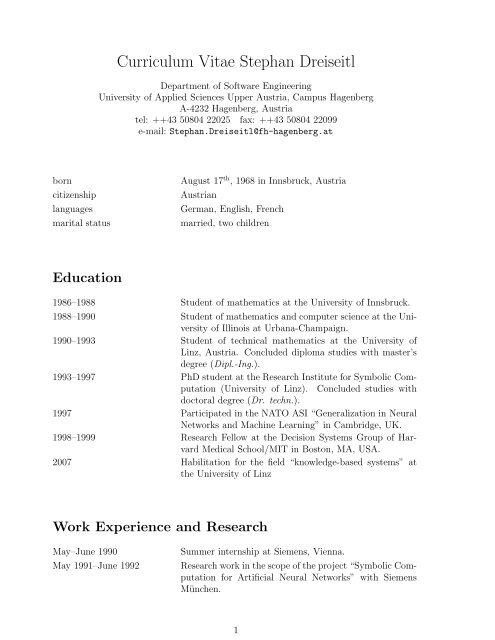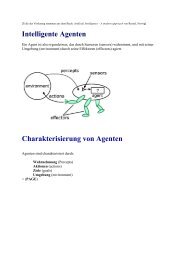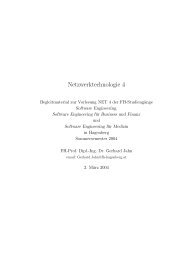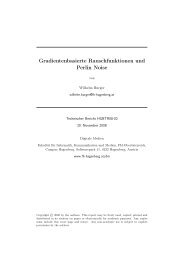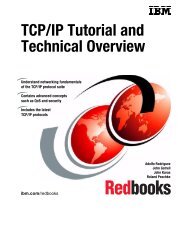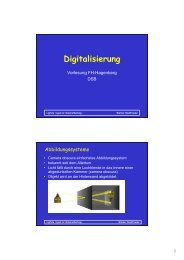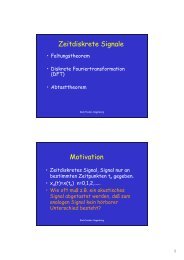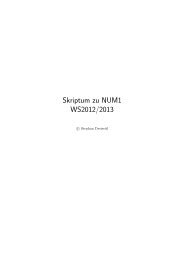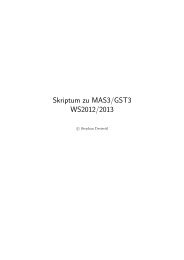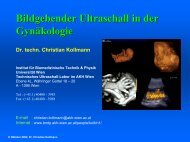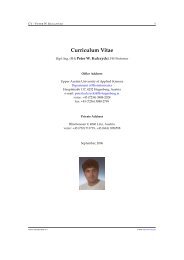Curriculum Vitae Stephan Dreiseitl - Campus Hagenberg
Curriculum Vitae Stephan Dreiseitl - Campus Hagenberg
Curriculum Vitae Stephan Dreiseitl - Campus Hagenberg
You also want an ePaper? Increase the reach of your titles
YUMPU automatically turns print PDFs into web optimized ePapers that Google loves.
<strong>Curriculum</strong> <strong>Vitae</strong> <strong>Stephan</strong> <strong>Dreiseitl</strong><br />
Department of Software Engineering<br />
University of Applied Sciences Upper Austria, <strong>Campus</strong> <strong>Hagenberg</strong><br />
A-4232 <strong>Hagenberg</strong>, Austria<br />
tel: ++43 50804 22025 fax: ++43 50804 22099<br />
e-mail: <strong>Stephan</strong>.<strong>Dreiseitl</strong>@fh-hagenberg.at<br />
born August 17 th , 1968 in Innsbruck, Austria<br />
citizenship Austrian<br />
languages German, English, French<br />
marital status married, two children<br />
Education<br />
1986–1988 Student of mathematics at the University of Innsbruck.<br />
1988–1990 Student of mathematics and computer science at the University<br />
of Illinois at Urbana-Champaign.<br />
1990–1993 Student of technical mathematics at the University of<br />
Linz, Austria. Concluded diploma studies with master’s<br />
degree (Dipl.-Ing.).<br />
1993–1997 PhD student at the Research Institute for Symbolic Computation<br />
(University of Linz). Concluded studies with<br />
doctoral degree (Dr. techn.).<br />
1997 Participated in the NATO ASI “Generalization in Neural<br />
Networks and Machine Learning” in Cambridge, UK.<br />
1998–1999 Research Fellow at the Decision Systems Group of Harvard<br />
Medical School/MIT in Boston, MA, USA.<br />
2007 Habilitation for the field “knowledge-based systems” at<br />
the University of Linz<br />
Work Experience and Research<br />
May–June 1990 Summer internship at Siemens, Vienna.<br />
May 1991–June 1992 Research workinthescopeoftheproject “Symbolic Computation<br />
for Artificial Neural Networks” with Siemens<br />
München.<br />
1
October 1993–March 1996 Research work in the scope of the project “Hybrid Evolutionary<br />
Programming” with the Real World Computing<br />
Partnership, Japan.<br />
June–August 1994 Visiting researcher at the Orthopedic Engineering Research<br />
Group of the Carolinas Medical Center in Charlotte,<br />
NC, USA.<br />
October 1996–February 2000 Lecturer formathematics attheUpper Austria University<br />
of Applied Sciences at <strong>Hagenberg</strong>, Austria.<br />
November 1997–August 1998 Senior software developer for RISC Software GmbH.<br />
September 1999–August 2000 Research assistant at the Research Institute for Symbolic<br />
Computation.<br />
from October 2000 Professor of mathematics at the Upper Austria University<br />
of Applied Sciences at <strong>Hagenberg</strong>, Austria.<br />
from March 2002 Lectures at the Harvard-MIT Division of Health Sciences<br />
and Technology, Cambridge, MA, USA.<br />
from October 2002 Lecturer at the University of Health Sciences and Technology<br />
Tirol (UMIT), Austria.<br />
from September 2005 Lecturer attheUniversity ofAppliedSciences oftheManagement<br />
Center Innsbruck, Austria.<br />
April 2006–September 2008 Research fellow at the University of Health Sciences and<br />
Technology Tirol (UMIT), Austria.<br />
November 2007–April 2010 AdjunctfacultyattheDecisionSystemsGroupofHarvard<br />
Medical School/MIT in Boston, MA, USA.<br />
from March 2009 Adjunct Professor, Dept. of Biomedical Sciences and Engineering,<br />
University of Health Sciences and Technology<br />
Tirol (UMIT), Austria.<br />
Honors<br />
1988–1989 Fulbright scholar at the University of Illinois.<br />
1993 Diploma graduation with distinction, Johannes Kepler<br />
University, Austria.<br />
1997 Award of the Austrian science minister for outstanding<br />
academic achievements.<br />
1997 Doctoral graduation with highest honors (sub auspiciis<br />
praesidentis), Johannes Kepler University, Austria.<br />
1998–1999 Erwin-Schrödinger scholarship of the Austrian Science<br />
Foundation for postdoc position at Harvard Medical<br />
School/MIT.<br />
2004, 2005 Best teacher awards, degree programs Software Engineering<br />
and Bioinformatics, Upper Austria University of Applied<br />
Sciences at <strong>Hagenberg</strong>, Austria.<br />
2
Activities in the Scientific Community<br />
Referee for the journals Biomed Central, Journal of Biomedical Informatics, IEEE<br />
Transactions on Robotics and Automation, Medical Decision Making, Medical Physics,<br />
Artificial Intelligence in Medicine, Journal of the American Medical Informatics Association,<br />
Clinical Neurophysiology, Applied Intelligence, Computational Statistics &<br />
Data Analysis, International Journal of Biomedical Imaging, Computers in Biology<br />
and Medicine, Medical & Biological Engineering & Computing, Journal of Electronic<br />
Commerce Research, Journal of the American Medical Informatics Association.<br />
Program committee member of the workshops ROC Analysis in Artificial Intelligence<br />
(2004) and ROC Analysis in Machine Learning (2005,2006).<br />
Journal and Conference Papers<br />
[1] S. <strong>Dreiseitl</strong> and M. Osl. Testing the calibration of classification models from first<br />
principles. In Proceedings of the AMIA Annual Fall Symposium 2012, pages 164–<br />
169, Chicago, USA, 2012.<br />
[2] G. Binenbaum, G.S. Ying, G.E. Quinn J. Huang, S. <strong>Dreiseitl</strong>, J. Antigua, N. Foroughi,<br />
andS.Abbasi. TheCHOPpostnatalweight gain, birthweight, andgestational<br />
age retinopathy of prematurity risk model. Archives of Opthalmology, 130(12):1560–<br />
1565, 2012.<br />
[3] M. Osl, M. Netzer, S. <strong>Dreiseitl</strong>, and C. Baumgartner. Applied data mining: From<br />
biomarker discovery to decision support systems. In Z. Trajanoski, editor, Computational<br />
medicine: tools and challenges, chapter 10, pages 173–184. Springer, 2012.<br />
[4] S. <strong>Dreiseitl</strong>, M. Pivec, and M. Binder. Differences in examination characteristics of<br />
pigmented skin lesions: results of an eye tracking study. Artificial Intelligence in<br />
Medicine, 54:201–205, 2012.<br />
[5] S. <strong>Dreiseitl</strong> and M. Osl. Effect of reject option on classifier performance. In Proceedings<br />
of the 23rd European Modeling and Simulation Symposium (EMSS2011), pages<br />
176–180, Rome, Italy, 2011.<br />
[6] S. <strong>Dreiseitl</strong> andM. Osl. Effects ofdatagrouping oncalibrationmeasures ofclassifiers.<br />
In Computer Aided Systems Theory—EUROCAST 2011 (LNCS 6927), pages 359–<br />
366, Las Palmas, Spain, 2011.<br />
[7] M. Osl and S. <strong>Dreiseitl</strong>. Early diagnosis of acute myocardial infarction using kernel<br />
methods. In Proceedings of the 8th IASTED International Conference on Biomedical<br />
Engineering, pages 175–180, Innsbruck, Austria, 2011.<br />
[8] G. Binenbaum, G. Ying, G.E. Quinn, S. <strong>Dreiseitl</strong>, K. Karp, R.S. Roberts, H. Kirpalani,<br />
and the PINT study group. A clinical prediction model to stratify ROP risk<br />
using postnatal weight gain. Pediatrics, 127(3):e607–e614, 2011.<br />
3
[9] S. <strong>Dreiseitl</strong>, M. Osl, C. Baumgartner, and S. Vinterbo. An evaluation of heuristics<br />
for rule ranking. Artificial Intelligence in Medicine, 50(3):175–180, 2010.<br />
[10] M. Osl, S. <strong>Dreiseitl</strong>, J.Kim, K.Patel, C. Baumgartner, andL. Ohno-Machado. Effect<br />
of data combination on predictive modeling: A study using gene expression data. In<br />
Proceedings of the AMIA Annual Fall Symposium 2010, pages 567–571, Washington<br />
DC, USA, 2010.<br />
[11] S. <strong>Dreiseitl</strong>, M. Osl, C. Scheibböck, and M. Binder. Outlier detection with one-class<br />
SVMs: An application to melanoma prognosis. In Proceedings of the AMIA Annual<br />
Fall Symposium 2010, pages 172–176, Washington DC, USA, 2010.<br />
[12] C. Scheibböck, T. Mehl, D. Rafolt, S. <strong>Dreiseitl</strong>, K. Schlager, J. Weingast, and<br />
M. Binder. Prediction of metastatic disease by computer aided interpretation of<br />
tumour markers in patients with malignant melanoma: a feasibility study. In Proceedings<br />
of ehealth2010: Health Informatics meets ehealth, pages 161–166, Vienna,<br />
Austria, 2010.<br />
[13] S. <strong>Dreiseitl</strong>, K. Auracher, S. Puig, and J. Malvehy. Modeling of standardized data<br />
entry in dermoscopy. In Proceedings of the 21st European Modeling and Simulation<br />
Symposium (EMSS2009), pages 184–188, Tenerifa, Spain, 2009.<br />
[14] S. <strong>Dreiseitl</strong>. Data processing beyond visual interpretation. In Proceedings of the 10th<br />
International Congress of Dermatology, pages 81–86, Prague, Czech Republic, 2009.<br />
[15] S. <strong>Dreiseitl</strong> and M. Osl. Feature selection based on pairwise classification performance.<br />
InComputer Aided Systems Theory—EUROCAST 2009 (LNCS 5717), pages<br />
769–776, Las Palmas, Spain, 2009.<br />
[16] S. <strong>Dreiseitl</strong> and L. Ohno-Machado. Support vector machines. In M.W. Kattan, editor,<br />
Encyclopedia of Medical Decision Making, pages 1101–1105. SAGE Publications,<br />
2009.<br />
[17] M.Osl, S.<strong>Dreiseitl</strong>, F.Cerqueira, M.Netzer, B.Pfeifer, andC.Baumgartner. Demoting<br />
redundant features to improve the discriminatory ability in cancer data. Journal<br />
of Biomedical Informatics, 42:721–725, 2009.<br />
[18] M. Osl, C. Baumgartner, B. Tilg, and S. <strong>Dreiseitl</strong>. On the combination of logistic<br />
regression and local probability estimates. African Journal of Information and<br />
Communication Technology, 5:84–90, 2009. Extended version of the paper [21].<br />
[19] S. <strong>Dreiseitl</strong>, M. Binder, K. Hable, and H. Kittler. Computer versus human diagnosis<br />
of melanoma: Evaluation of the feasibility of an automated diagnostic system in a<br />
prospective clinical trial. Melanoma Research, 19:180–184, 2009.<br />
[20] C. Scheibböck, S. <strong>Dreiseitl</strong>, and M. Binder. Applicability of mobile phones for teledermatology:<br />
a pilot study. In Proceedings of the International Conference on Health<br />
Informatics—HEALTHINF 2009, pages 474–477, Porto, Portugal, 2009.<br />
[21] M. Osl, C. Baumgartner, B. Tilg, and S. <strong>Dreiseitl</strong>. On the combination of logistic<br />
regression and local probability estimates. In Proceedings of the 3rd International<br />
Conference on Broadband Communications, Information Technology and Biomedical<br />
Applications, pages 124–128, Pretoria, South Africa, 2008.<br />
4
[22] M. Osl, L. Ohno-Machado, and S. <strong>Dreiseitl</strong>. Improving calibration of logistic regression<br />
models by local estimates. In Proceedings of the AMIA Annual Fall Symposium<br />
2008, pages 535–539, Washington DC, USA, 2008.<br />
[23] M. Osl, S. <strong>Dreiseitl</strong>, B. Pfeifer, K. Weinberger, H. Klocker, G. Bartsch, G. Schäfer,<br />
B. Tilg, A. Graber, and C. Baumgartner. A new rule-based algorithm for identifying<br />
metabolic markers in prostate cancer using tandem mass spectronomy. Bioinformatics,<br />
24:2908–2914, 2008.<br />
[24] S. <strong>Dreiseitl</strong>, M. Binder, S. Vinterbo, and H. Kittler. Applying a decision support<br />
system in clinical practice: Results from melanoma diagnosis. In Proceedings of the<br />
AMIA Annual Fall Symposium 2007, pages 191–195, Chicago, USA, 2007.<br />
[25] S. <strong>Dreiseitl</strong>. Training multiclass classifiers by maximizing the volume under the ROC<br />
surface. InComputer Aided Systems Theory—EUROCAST2007 (LNCS 4739),pages<br />
878–885, Las Palmas, Spain, 2007.<br />
[26] M. Binder, H. Kittler, H. Pehamberger, and S. <strong>Dreiseitl</strong>. Differentiation between<br />
benign and malignant skin tumors by image analysis, neural networks, and other<br />
methods of machine learning. In K.-P. Wilhelm et al., editors, Bioengineering of the<br />
Skin: Skin Imaging and Analysis, pages 297–304. Informa Healthcare, 2nd edition,<br />
2006.<br />
[27] S. Vinterbo and S. <strong>Dreiseitl</strong>. A note on solution sizes in the haplotype tagging SNPs<br />
problem. In Proceedings of the 2nd European Modeling and Simulation Symposium<br />
(EMSS2006), pages 659–663, 2006.<br />
[28] S.A. Vinterbo, S. <strong>Dreiseitl</strong>, and L. Ohno-Machado. Approximation properties of<br />
haplotype tagging. BMC Bioinformatics, 7(8), 2006.<br />
[29] S. <strong>Dreiseitl</strong>, A. Harbauer, M. Binder, and H. Kittler. Nomographic representation of<br />
logistic regression models: A case study using patient self-assessment data. Journal<br />
of Biomedical Informatics, 38:389–394, 2005.<br />
[30] S. <strong>Dreiseitl</strong> andM. Binder. Dophysicians valuedecision support? Alookatthe effect<br />
of decision support systems on physician opinion. Artificial Intelligence in Medicine,<br />
33:25–30, 2005.<br />
[31] S. Vinterbo, S. <strong>Dreiseitl</strong>, and L. Ohno-Machado. A testing procedure for htSNP approximation<br />
algorithms. In Proceedings of the Workshop on Intelligent Data Analysis<br />
in Medicine and Pharmacology (IDAMAP 2004), pages 101–105, 2004.<br />
[32] S. <strong>Dreiseitl</strong>, S. Vinterbo, and L. Ohno-Machado. Disambiguation data: Extracting<br />
information from anonymized sources. Journal of the American Medical Informatics<br />
Association, 9:S110–S114, 2002.<br />
[33] S. <strong>Dreiseitl</strong> and L. Ohno-Machado. Logistic regression and artificial neural network<br />
classification models: a methodology review. Journal of Biomedical Informatics,<br />
35:352–359, 2002.<br />
5
[34] L. Ohno-Machado, S. Vinterbo, S. <strong>Dreiseitl</strong>, T.K. Jenssen, and W. Kuo. Comparing<br />
imperfect measurements with the Bland-Altman technique: application in gene expression<br />
analysis. In Proceedings of the AMIA Annual Fall Symposium 2002, pages<br />
572–576, San Antonio, USA, 2002.<br />
[35] L.Ohno-Machado, S.Vinterbo, andS.<strong>Dreiseitl</strong>. Effectsofdataanonymizationbycell<br />
suppression on descriptive statistics and predictive modeling performance. Journal<br />
of the American Medical Informatics Association, 9:S115–S119, 2002.<br />
[36] S. <strong>Dreiseitl</strong>, L. Ohno-Machado, S. Vinterbo, H. Billhardt, and M. Binder. A comparison<br />
of machine learning methods for the diagnosis of pigmented skin lesions. Journal<br />
of Biomedical Informatics, 34:28–36, 2001.<br />
[37] W. Jacak, K. Pröll, and S. <strong>Dreiseitl</strong>. Conflict management in an intelligent multiagent<br />
robotics system: Finite state machine approach. In Computer Aided Systems<br />
Theory—EUROCAST’01 (LNCS 2178), pages 52–66, 2001.<br />
[38] W. Jacak, S. <strong>Dreiseitl</strong>, K.Pröll, andJ.Rozenblit. Conflict management inmultiagent<br />
robotic system: FSM and fuzzy logic approach. In Proceedings of the IEEE International<br />
Conference on Systems, Man, and Cybernetics (SMC’2001), pages 1593–1598,<br />
2001.<br />
[39] S. Vinterbo, L. Ohno-Machado, and S. <strong>Dreiseitl</strong>. Hiding information by cell suppression.<br />
In Proceedings of the AMIA Annual Fall Symposium 2001, pages 726–730,<br />
Washington, USA, 2001.<br />
[40] S. <strong>Dreiseitl</strong>, L. Ohno-Machado, and M. Binder. Comparing three-class diagnostic<br />
tests by three-way ROC analysis. Medical Decision Making, 20:323–331, 2000.<br />
[41] S. <strong>Dreiseitl</strong>, H. Kittler, H. Ganster, and M. Binder. Classifying pigmented skin<br />
lesions with machine learning methods. In Artificial Neural Networks in Medicine<br />
and Biology: Proceedings of the ANNIMAB-1 Conference, pages 174–179. Springer<br />
London, 2000.<br />
[42] F. Atienza, N. Martinez-Alzamora, J.A. De Velasco, S. <strong>Dreiseitl</strong>, and L. Ohno-<br />
Machado. Risk stratification in heart failure using artificial neural networks. In<br />
Proceedings of the AMIA Annual Fall Symposium 2000, pages 32–36, 2000.<br />
[43] M. Binder, H. Kittler, S. <strong>Dreiseitl</strong>, H. Ganster, K. Wolff, and H. Pehamberger.<br />
Computer-aided epiluminescence microscopy of pigmented skin lesions: The value<br />
of clincal data for the classification process. Melanoma Research, 10:556–561, 2000.<br />
[44] M. Binder and S. <strong>Dreiseitl</strong>. Critical appraisal: The interpretation of test results.<br />
Journal of Cutaneous Medicine and Surgery, 4:19–25, 2000.<br />
[45] L.K. Goodwin, S.G. Maher, L. Ohno-Machado, S. <strong>Dreiseitl</strong>, S. Vinterbo, M.A. Iannacchione,<br />
W.E. Hammond, and P. Crockett. Building knowledge in a complex<br />
preterm birth problem domain. In Proceedings of the AMIA Annual Fall Symposium<br />
2000, pages 305–309, 2000.<br />
[46] K. Pröll, W. Jacak, and S. <strong>Dreiseitl</strong>. Software agent-based intelligent control of<br />
robot manipulator. In Proceedings of the International Conference on Intelligent<br />
Autonomous Systems (IAS’2000), Venice, Italy, 2000.<br />
6
[47] S. <strong>Dreiseitl</strong>, L. Ohno-Machado, and S. Vinterbo. Evaluating variable selection methods<br />
for diagnosis of myocardial infarction. In Proceedings of the AMIA Annual Fall<br />
Symposium 1999, pages 246–250, 1999.<br />
[48] W. Jacak and S. <strong>Dreiseitl</strong>. Intelligent robotic agent combining reactive and cognitive<br />
capabilities. In S. Tzafestas, editor, Advances in Intelligent Autonomous Systems,<br />
pages 93–113. Kluwer Acad. Pub., 1999.<br />
[49] W. Jacak, B. Buchberger, and S. <strong>Dreiseitl</strong>. Lifelong learning based intelligent robotic<br />
agent: Novel neural network approach. In Proceedings of the 1997 Real World Computing<br />
Symposium (RWC’97), Tokyo, Japan, 1997.<br />
[50] W. Jacak and S. <strong>Dreiseitl</strong>. Lifelong learning approach to intelligent agents modeling.<br />
In Computer Aided Systems Theory—EUROCAST’97 (LNCS 1333), pages 367–379,<br />
Gran Canaria, Spain, 1997.<br />
[51] W. Jacak and S. <strong>Dreiseitl</strong>. Multisensor reactive robot arm. In Proceedings of the 1st<br />
Workshop on Teleoperations and Robotics Applications in Science and Arts, pages<br />
41–54, Linz, Austria, 1997.<br />
[52] W. Jacak and S. <strong>Dreiseitl</strong>. Intelligent robotic agent combining reactive and cognitive<br />
capabilities. In Proceedings of IEEE International Conference on Systems, Man and<br />
Cybernetics (SMC’97), Orlando, USA, 1997.<br />
[53] S. <strong>Dreiseitl</strong>. Modeling of discrete dynamical systems by neural networks and genetic<br />
algorithms. In Proceedings of the 13th European Meeting on Cybernetics and Systems<br />
Research (EMCSR’96), pages 89–94, Vienna, Austria, 1996.<br />
[54] S. <strong>Dreiseitl</strong>. Discrete dynamical system modeling by evolved neural networks. In<br />
Proceedings of the 11th International Conference on Systems Engineering (ICSE’96),<br />
pages 19–24, Las Vegas, USA, 1996.<br />
[55] W. Jacak, B. Buchberger, S. <strong>Dreiseitl</strong>, and T. Kubik. Intelligent robotic arm based<br />
on reactive control. In Proceedings of the 5th International Workshop on Robotics<br />
in the Alpe-Adria-Danube Region (RAAD’96), pages 297–302, Budapest, Hungary,<br />
1996.<br />
[56] W. Jacak and S. <strong>Dreiseitl</strong>. Robotic agent control combining reactive and learning<br />
capabilities. InProceedingsof the IEEE International Conferenceon Neural Networks<br />
(ICNN’96), pages 1682–1686, Washington, USA, 1996.<br />
[57] W. Jacak, S. <strong>Dreiseitl</strong>, and R. Muszyński. Neural network-based modeling of robot<br />
action effects in conceptual statespace ofreal world. InProceedings of the IEEE/RSJ<br />
International Conference on Intelligent Robots and Systems (IROS’96), pages 1149–<br />
1156, Osaka, Japan, 1996.<br />
[58] W. JacakandS. <strong>Dreiseitl</strong>. Neural network-based modelingofintelligent roboticagent<br />
behavior. In Proceedings of the International Conference on Information Systems<br />
Analysis and Synthesis (ISAS’96), pages 82–89, Orlando, USA, 1996.<br />
[59] S. <strong>Dreiseitl</strong>, W. Jacak, T. Kubik, and R. Muszyński. Neural processing-based robot<br />
kinematics modeling and calibration for pose control. In Proceedings of the 12th<br />
International Conferenceon Systems Science,pages288–295,Wroclaw, Poland, 1995.<br />
7
[60] S. <strong>Dreiseitl</strong> and W. Jacak. Genetic algorithm-based neural networks for dynamical<br />
system modeling. In Proceedings of the IEEE International Conference on Evolutionary<br />
Computing (ICEC’95), pages 602–607, Perth, Australia, 1995.<br />
[61] B. Buchberger, S. <strong>Dreiseitl</strong>, I. Duleba, W. Jacak, T. Kubik, R. Muszynski, and<br />
D. Schlosser. Hybrid programming approach to the design of an intelligent robotic<br />
agent acting in the real world. In Proceedings of the 1995 Real World Computing<br />
Symposium (RWC’95), pages 15–16, Tokyo, Japan, 1995.<br />
[62] W. Jacak and S. <strong>Dreiseitl</strong>. Hybrid evolutionary programming—the tools for CAST.<br />
In Computer Aided Systems Theory—EUROCAST’95 (LNCS 1030), pages 289–304,<br />
Innsbruck, Austria, 1995.<br />
[63] W. Jacak, S. <strong>Dreiseitl</strong>, T. Kubik, and D. Schlosser. Distributed planning and control<br />
of intelligent robot’s arm motion based on symbolic and neural processing. In<br />
Proceedings of the IEEE International Conference on Systems, Man and Cybernetics<br />
(SMC’95), volume 3, pages 2898–2903, Vancouver, Canada, 1995.<br />
[64] S.<strong>Dreiseitl</strong>andT.Kubik. Neural-processedinversekinematicsofrobotmanipulators.<br />
In Proceedings of the Third International Conference on Automation, Robotics, and<br />
Computer Vision, volume 3, pages 1748–1751, Singapore, 1994.<br />
[65] S. <strong>Dreiseitl</strong> and D. Wang. Automatic generation of C++ code for neural network<br />
simulation. In New trends in neural computing (LNCS 686), pages 358–363, Sitges,<br />
Spain, 1993.<br />
Talks and Posters at Conferences<br />
[1] S. <strong>Dreiseitl</strong>. Client-server system for standardized dermoscopy report (talk). 3rd<br />
World Congress of Teledermatology, Amsterdam, Netherlands, 2010.<br />
[2] S. <strong>Dreiseitl</strong>. Computer support for teledermatology (invited talk). 7th World<br />
Congress on Melanoma, Vienna, Austria, 2009.<br />
[3] S. <strong>Dreiseitl</strong>, K. Auracher, S. Puig, and J. Malvehy. Computer support for standardized<br />
dermoscopy report (poster). First World Meeting of Interdisciplinary<br />
Melanoma/Skin Cancer Centers, Barcelona, Spain, 2007.<br />
[4] S. <strong>Dreiseitl</strong>, M. Binder, and H. Kittler. Investigating the benefits of decision support<br />
systems: Lessons from melanoma diagnosis (poster). 28th Annual Meeting of the<br />
Society for Medical Decision Making, Boston, USA, 2006.<br />
[5] S.<strong>Dreiseitl</strong>andC.Grana. Calibration/standardization: Animportantissueforimage<br />
acquisition (invited talk). First Congress of the International Dermoscopy Society,<br />
Naples, Italy, 2006.<br />
[6] S. <strong>Dreiseitl</strong>. Classifiers (invited talk). 10th World Congress on Cancers of the Skin,<br />
Vienna, Austria, 2005.<br />
8
[7] H. Kittler, S. <strong>Dreiseitl</strong>, and M. Binder. How easily can dermatologists be influenced<br />
by a decision-support system? (poster). 24th Annual Meeting of the Society for<br />
Medical Decision Making, Baltimore, USA, 2002.<br />
[8] A. Harbauer, H. Kittler, S. <strong>Dreiseitl</strong>, and M. Binder. Evaluating a patient’s ability to<br />
self-assess melanoma risk (poster). In 24th Annual Meeting of the Society for Medical<br />
Decision Making, Baltimore, USA, 2002.<br />
[9] S. <strong>Dreiseitl</strong> and L. Ohno-Machado. Self-organizing maps for visualization of medical<br />
data sets (poster). AMIA Annual Fall Symposium, Washington, USA, 1999.<br />
[10] L. Ohno-Machado, S. Vinterbo, A. Ohrn, and S. <strong>Dreiseitl</strong>. Clinical data processing<br />
tools: A machine learning resource (poster). AMIA Annual Fall Symposium,<br />
Washington, USA, 1999.<br />
9


